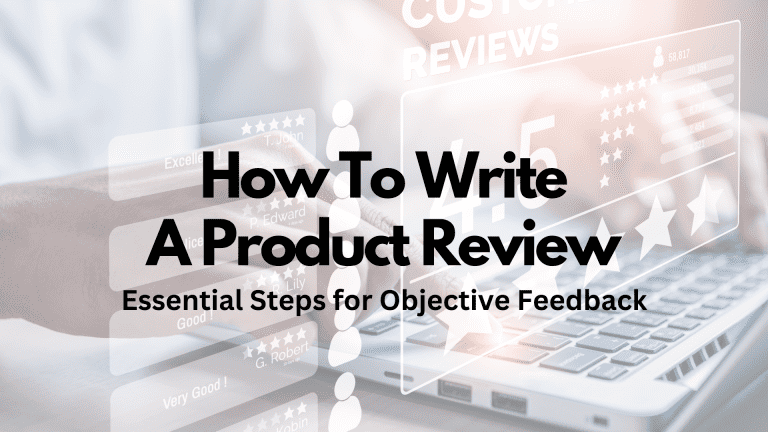
Writing a product review is a process that involves evaluating a product and sharing your opinion about it.
As a reviewer, your key role is to help potential buyers make informed decisions by providing a clear, honest, and fair assessment.
Establishing yourself as a credible source of information is crucial. By consistently offering well-considered and balanced reviews, you can build authority and trust with your audience.
When preparing to write a review, it's important to use the product as it's intended by the manufacturer.
This hands-on experience allows you to provide a detailed account of the product's performance, features, and potential drawbacks.
Your review should be structured in a way that is easy for readers to follow and should use plain language to explain your findings.
Transparency is paramount; acknowledge if you received the product for free or if your review is sponsored in some way.
Your credibility as a reviewer grows with each product analysis.
The key to successful product reviews lies in your ability to convey your experience objectively and without bias.
Remember to keep your review focused on the product itself rather than letting personal preferences dominate your judgment.
Sharing both the positives and the negatives creates a balanced view that readers will appreciate for its trustworthiness.
Researching the Product

Before you write a product review, it's important to gather detailed information about the product itself and explore the alternatives available in the market to provide a thorough comparison.
Gathering Information
Your first step in researching a product is to collect all relevant information about its features and benefits.
Analyze the product's specifications and understand the unique selling points that differentiate it from others. Here's a quick guide:
- Product Specifications: Look at the size, weight, materials, and technology involved.
- User Manuals/Guides: These can provide insights into the product's functionality and features.
- Manufacturer's Information: They often list detailed features, benefits, and sometimes comparison charts.
Exploring Alternatives
To give a well-rounded review, you need to know what else is out there. Comparing the product with its alternatives can help highlight why it might be the better choice, or what it lacks.
- Identify Competitors: List comparable products by other brands that offer similar features.
- Feature Comparison: Create a table to compare the features, prices, and benefits of each product side by side.
| Feature | Product You're Reviewing | Alternative 1 | Alternative 2 |
|---|---|---|---|
| Price | |||
| Key Feature | |||
| Unique Benefit |
- Real-World Usage: Consider looking for how the alternatives perform in everyday situations, possibly through customer feedback or professional reviews.
Understanding the Target Market

When writing a product review, it's crucial to recognize the composition and characteristics of the target market. This ensures your review speaks directly to the intended audience and addresses their specific needs and preferences.
Identifying Potential Buyers
Begin by skimming through demographics to understand who the potential buyers are. Age, location, and socioeconomic status are fundamental in pinpointing your audience. For example:
- Age Group: 25-34 years old
- Location: Urban areas
- Socioeconomic Status: Middle-income earners
Assessing these aspects will sharpen your understanding of who will read your review and what information they are seeking.
Analyzing Needs and Preferences
Next, engage in qualitative research to glean insights into your target audience's needs and preferences.
You might look into forums, surveys, or customer reviews where your niche audience discusses their pain points and desires. Structuring this information systematically can help, as shown below:
| Pain Point | Customer Preference | Relevant for Product Type |
|---|---|---|
| Durability | Long-lasting items | Outdoor gear |
| Efficiency | Quick and easy use | Competitive Pricing |
| Affordability | Competitive pricing | Tech gadgets |
By addressing these aspects in your review, you reassure readers that your review reflects the viewpoints of actual consumers.
Your goal is to validate the buyer's experience with the product and ensure it aligns with their expectations and the value they seek.
Testing the Product

When you're setting out to write a product review, the testing process is crucial to ensure you provide a clear, honest evaluation based on first-hand experience.
Evaluating Core Features
Before you begin, familiarize yourself with the product's advertised core features. These are the aspects that the manufacturer emphasizes as the main selling points.
Create a checklist in a tabular format to systematically assess each feature. For instance:
| Feature | Expected Performance | Actual Performance | Notes |
|---|---|---|---|
| Feature 1 | Describe expected outcome | Record your observation | Any discrepancies? |
| Feature 2 | Describe expected outcome | Record your observation | Any discrepancies? |
As you work through the list, take note of the ease of use and whether the experience aligns with the manufacturer's promises.
It is important to remain authentic and present a balanced view, highlighting both strengths and weaknesses.
Personal Experiences
Beyond the technical aspects, discussing personal experiences with the product offers a unique perspective that can be especially valuable to your readers.
Share specifics about the context in which you used the product and how it fits into your daily routine. For example:
- Day 1: Note the initial setup process and ease of use out of the box.
- Day 7: Comment on any changes in usability or performance after a period of regular use.
Remember to interject your recommendations only when they are informed by your testing.
Always prioritize honesty in your accounts to establish trust with your audience.
Your readers depend on your direct and clear insight to guide their purchasing decisions.
Writing a Product Review

When writing a product review, your integrity is key. Stay transparent and provide a true representation of your experience with the product.
Product Description
Begin by describing the product features clearly and accurately.
Focus on the specifics like the build quality, design, ease of use, and the functionality it offers. If it's a tech gadget, list the technical specifications such as processor speed, memory, and battery life. For example:
- Processor: Snapdragon 865
- Memory: 6GB RAM
- Battery Life: Up to 14 hours
- Design: Sleek, with a matte finish
Balancing Pros and Cons
When listing the advantages, be explicit about how each pro enhances the product's value.
Pros:
- Increased efficiency
- User-friendly interface
- Robust construction
For the drawbacks, don't shy away from mentioning any noticeable issues or limitations.
It's important to explain how these cons may affect the user's experience.
Cons:
- Higher cost compared to similar models
- Limited color options
- Requires frequent updates
Your approach should be balanced, presenting both the benefits and the drawbacks in equal measure.
Your honesty in sharing what you genuinely liked and disliked will help build trust with your audience.
Structuring Your Review

When writing a product review, begin with a summary. Highlight what the product is and your overall impression. This lets readers quickly understand the gist of your review.
Introduction
- Start with the product name and purpose.
- Mention your reason for reviewing and the context of use.
- Present your initial thoughts briefly.
Next, list the pros and cons of the product. This format helps readers weigh the product's benefits against its drawbacks efficiently.
Pros and Cons
- Pros: Bullet-point the advantages.
- Cons: Outline any disadvantages.
Now, expand on each pro and con with specifics. Offer examples of the product’s performance, design, utility, and other relevant features.
Detailing Pros and Cons
- Provide context for each point.
- Use descriptive, yet succinct, language.
- Relate features to potential user experience.
Include a review template section—a structured approach to breaking down key aspects, such as features, quality, value, and usability. Rate these areas on a consistent scale for clarity.
Review Template
- Features:
- Mention unique or standout attributes.
- Rate the feature set out of 10.
- Quality:
- Discuss build quality and materials.
- Rate the quality out of 10.
- Value:
- Assess price to performance.
- Rate the value for money out of 10.
Using Affiliates for Product Reviews

When incorporating affiliate marketing into your product reviews, you enter a partnership where you potentially earn a commission for promoting a company's products. You need to join an affiliate program, such as Amazon Associates, which is one of the most popular platforms.
As an affiliate, you'll create content that encourages your readers to purchase through your affiliate links. Here's how to approach creating affiliate product reviews:
- Select Products Wisely:
- Choose products that align with your audience's interests.
- Opt for items you are confident to endorse.
- Disclosure is Key:
- Be transparent about the affiliate relationship.
- Follow the FTC guidelines to inform your readers.
- Professional vs. Affiliate Reviews:
- While professional reviews focus on detailed analysis, affiliate reviews often highlight the benefits with the intent to sell.
- Provide honest feedback to build trust, even with the incentive of earning commissions.
- Content Authenticity:
- Use the product personally to provide genuine recommendations.
- Authentic experiences enhance credibility.
- Understand the Commission Structure:
- Review the terms of your affiliate program.
- Commission rates can vary, so ensure the potential earnings are worth your efforts.
- Balanced Information:
- Address both pros and cons.
- Readers value reviews that give a full picture of the product.
Optimizing for Search Engines

When writing a product review, SEO (Search Engine Optimization) is pivotal to ensure your content ranks well on Google search and other search engines. Your primary aim is to make your review easily discoverable by users searching for reviews about that specific product.
Firstly, select keywords relevant to the product you’re reviewing. Incorporate them naturally into your review, especially in the title, headings, and the first paragraph. Utilize keyword research tools to find terms that potential readers might use to find reviews online.
Make use of lists and bullet points to break down features or pros and cons, as this format is SEO-friendly and enhances readability. For example:
Product Features:
- High-resolution camera
- Long-lasting battery
- User-friendly interface
Implement schema markup to provide search engines with detailed information about your review. This can include the product name, rating, and price, allowing your review to potentially appear as a rich snippet in search results.
Lastly, encourage online reviews from your audience. Comments and user engagement can improve SEO as they provide fresh, relevant content, which search engines value. Always respond to comments to foster a community and further boost engagement.
Enhancing Credibility When You Write A Product Review

When writing a product review, your credibility is paramount. Be authentic in your assessment—readers can detect when a review seems disingenuous or overly promotional. If your review is one of many customer reviews, it should stand out by offering substantial, user-focused insight rather than regurgitating specifications.
- Avoid fraudulent behavior such as creating fake reviews. This not only damages your reputation as a reviewer but also misleads potential buyers and undermines the trustworthiness of the platform on which you’re posting.
To avoid being mistaken for a scam, always provide evidence to support your opinions. This could be in the form of photos, videos, or direct comparisons with other products.
Quote credible sources when discussing product features to add weight to your review. Referencing reputable tech blogs, consumer reports, or experts in the field increases the reliability of your information.
| Action Item | Purpose |
|---|---|
| Use a factual tone | Maintains neutrality and avoids embellishment |
| Include personal experience | Adds authenticity and relatability |
| Detail your evaluation process | Gives readers a clear understanding of how you reached your conclusions |
Driving Consumer Action

When crafting a product review, incorporating a compelling call to action (CTA) is crucial for driving consumer action. Your CTA should guide readers on what to do next. To influence purchasing decisions, here are strategic points to consider:
- Be Persuasive: Convey the value for money that the product offers. A reader convinced of the product's worth is more likely to proceed to a purchase.
- Highlight Benefits: List the most significant benefits, making sure to link them to real-world utility.
- Improved efficiency
- Cost savings
- Longevity and reliability
- Use Urgency, Sparingly: Suggesting limited-time offers can enhance conversion rates, but use this tactic judiciously to maintain credibility.
- Visual Cues: Use formatting to draw attention to the CTA. Bold or italicize actionable phrases to stand out.
- Placement Matters: Position your CTA strategically within the review, ideally after a strong selling point, to nudge the reader towards making a purchase.
- Clear Instructions: Ensure your CTA provides straightforward instructions—this could significantly increase sales.
Building Trust Through Transparency

When writing a product review, your ultimate goal is to establish a connection with your readers through trust. Transparency is key in this process. You can achieve transparency by sharing both the strengths and weaknesses of a product openly. Acknowledge any bias or sponsorships; your candidness will lend authenticity to your review.
Incorporate social proof to support your claims. This could include:
- Customer testimonials
- User ratings
- Before and after photos
By presenting real-world evidence, you provide a balanced view that prospects can relate to.
Effective customer service stories can also enhance trust. If you've interacted with the company's customer service, narrate your experience. This insight adds depth and shows you care about post-purchase support, which is crucial for consumers.
Actively engaging with feedback on your review demonstrates that you value your readers' opinions and are open to discussion. Respond to comments; it signals that you seek to learn and improve, making your content trusted and reliable. Remember:
- Acknowledge differing opinions
- Address criticisms constructively
- Offer updates if your view changes
Leveraging Social Platforms

When writing a product review, using social platforms can amplify your message and boost credibility.
Your review can gain significant traction by tapping into a community passionate about the product's niche.
Start by identifying the relevant forums and social media groups where potential readers gather.
| Platform Type | Strategy |
|---|---|
| Forums | Engage in discussions and share your review link. |
| Social Networks | Post your review and use relevant hashtags. |
| Review Sites | Contribute your review to product-specific pages. |
Remember, authenticity is key on social platforms, so share your honest opinions and experiences.
Highlight both the pros and cons of the product to maintain a balanced perspective.
Utilize social proof by encouraging users who found your review valuable to like, comment, or share.
Engaging with your audience is pivotal.
Respond to comments and questions to demonstrate your commitment and build influence.
This interaction not only helps foster a connection but also increases the traffic to your review.
When leveraging these platforms, be mindful of each community's rules.
Avoid spammy behaviour and focus on contributing valuable insights to sustain your credibility and respect within the community.
By integrating your review strategically on social platforms, you increase its visibility and impact.
Call to Action (CTA)
Now, it's your turn!
Share your thoughts, experiences, or questions about any tips or tricks you use when you write a product review for your affiliate marketing business in the comments below.
Which strategy resonates most with you, and how do you plan to implement it?
If you found this guide valuable, share it with your network and fellow affiliates.
Let's create a community of empowered affiliate marketers driving success through automation!






